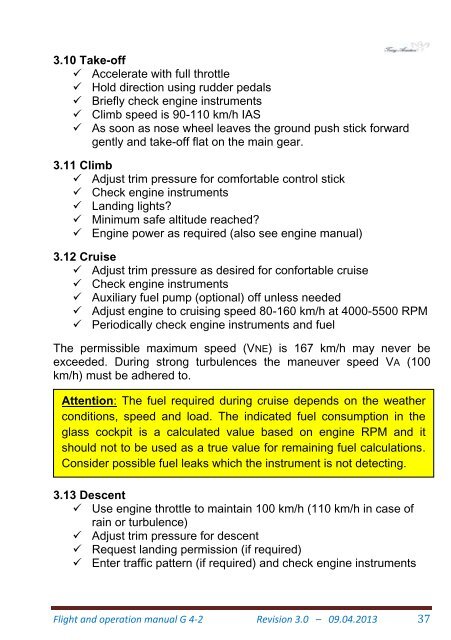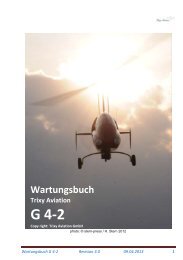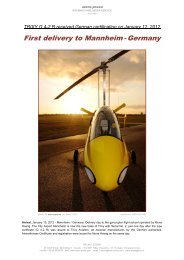Flight and Operation Manual Rev 3.0 on 09-04-2013 - Trixy Aviation
Flight and Operation Manual Rev 3.0 on 09-04-2013 - Trixy Aviation
Flight and Operation Manual Rev 3.0 on 09-04-2013 - Trixy Aviation
Create successful ePaper yourself
Turn your PDF publications into a flip-book with our unique Google optimized e-Paper software.
3.10 Take-off Accelerate with full throttle Hold directi<strong>on</strong> using rudder pedals Briefly check engine instruments Climb speed is 90-110 km/h IAS As so<strong>on</strong> as nose wheel leaves the ground push stick forwardgently <str<strong>on</strong>g>and</str<strong>on</strong>g> take-off flat <strong>on</strong> the main gear.3.11 Climb Adjust trim pressure for comfortable c<strong>on</strong>trol stick Check engine instruments L<str<strong>on</strong>g>and</str<strong>on</strong>g>ing lights? Minimum safe altitude reached? Engine power as required (also see engine manual)3.12 Cruise Adjust trim pressure as desired for c<strong>on</strong>fortable cruise Check engine instruments Auxiliary fuel pump (opti<strong>on</strong>al) off unless needed Adjust engine to cruising speed 80-160 km/h at 4000-5500 RPM Periodically check engine instruments <str<strong>on</strong>g>and</str<strong>on</strong>g> fuelThe permissible maximum speed (VNE) is 167 km/h may never beexceeded. During str<strong>on</strong>g turbulences the maneuver speed VA (100km/h) must be adhered to.Attenti<strong>on</strong>: The fuel required during cruise depends <strong>on</strong> the weatherc<strong>on</strong>diti<strong>on</strong>s, speed <str<strong>on</strong>g>and</str<strong>on</strong>g> load. The indicated fuel c<strong>on</strong>sumpti<strong>on</strong> in theglass cockpit is a calculated value based <strong>on</strong> engine RPM <str<strong>on</strong>g>and</str<strong>on</strong>g> itshould not to be used as a true value for remaining fuel calculati<strong>on</strong>s.C<strong>on</strong>sider possible fuel leaks which the instrument is not detecting.3.13 Descent Use engine throttle to maintain 100 km/h (110 km/h in case ofrain or turbulence) Adjust trim pressure for descent Request l<str<strong>on</strong>g>and</str<strong>on</strong>g>ing permissi<strong>on</strong> (if required) Enter traffic pattern (if required) <str<strong>on</strong>g>and</str<strong>on</strong>g> check engine instruments<str<strong>on</strong>g>Flight</str<strong>on</strong>g> <str<strong>on</strong>g>and</str<strong>on</strong>g> operati<strong>on</strong> manual G 4-2 <str<strong>on</strong>g>Rev</str<strong>on</strong>g>isi<strong>on</strong> <str<strong>on</strong>g>3.0</str<strong>on</strong>g> – <strong>09</strong>.<strong>04</strong>.<strong>2013</strong> 37







